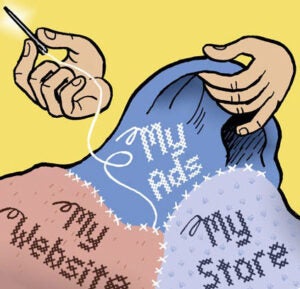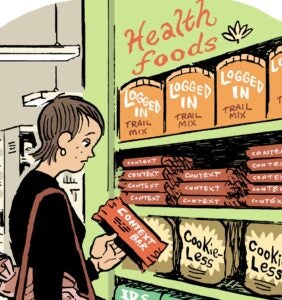 The 96-year-old Forbes Media has made an aggressive push into digital media.
The 96-year-old Forbes Media has made an aggressive push into digital media.
It’s invested in programmatic buying as well as native advertising through its BrandVoice platform. In October, it boasted that for the first time more than half (53%) of its total ad revenue came from digital advertising.
The media company’s future has remained murky, however, since Forbes Media announced one month later that it was up for sale. AdExchanger spoke with CRO Mark Howard about Forbes’ digital ad strategy as the company looks for a new owner.
AdExchanger: How would you describe your digital ad strategy today?
MARK HOWARD: The common thread behind everything we’re doing is our ability to deliver, track and report on all the different ad experiences that we offer our marketers and the big trend for last year was how do we deploy a DMP [data-management platform] so that we get better insights into the types of audiences these marketing solutions are reaching and how do we track the exposure and engagement of those ad products to various segments.
To what extent will this change next year?
As we enter a new year, digital will continue to be a primary driver of growth for us. BrandVoice and programmatic in particular are where we’re going to see hypergrowth in 2014 and that’s where we’re putting a lot of our energy and resources. BrandVoice, which represented 20% of our total advertising revenue in 2013, is the idea that brands can act as publishers and share information that’s valuable [in a native ad format on Forbes’ site].
What has been the impact as Forbes Media looks for a new owner?
It’s business as usual. We’re very focused on all the different things that we do from a product perspective and how that translates into ad product opportunities. As far as what is going on with the rest of the company, we are proceeding as always and focused on bringing new solutions to our advertisers, until I hear otherwise.
Let’s go back to your DMP provider. Who are you working with?
Our current DMP is Krux. We’ve been working with them for over a year now. There are three ways that they help us understand our audience. The first is, rather than being dependent on third parties like comScore and Nielsen to qualify our audiences, by implementing our DMP, we’ve been able to see who are the people that are consuming our content.
AdExchanger Daily
Get our editors’ roundup delivered to your inbox every weekday.
Daily Roundup
And so, as we’re talking to our marketing partners about opportunities for them across the site, we’ve got this data that lets us drill down into specific areas and share with them who the audience is that comes to each place.
The second aspect of that strategy has been how do we turn a number of microtargets into large targetable audience segments that are representative of the people that our advertisers are looking to reach? For example, Krux helps us use data from Exelate, BlueKai and Bizo to identify the thought leaders or IT decision-makers and put them together in a custom segment.
The third is campaign reporting. Whether it’s a display campaign or BrandVoice, we’re now able to identify the people that were exposed to the ads, cross-reference that with third-party data segments and show our advertisers the people who were exposed to the ad product.
What’s new with your programmatic strategy?
Our approach to the exchanges has been more focused on the open exchanges. The reality is the majority of our buyers are in the open exchange. And we’ve been working closely with Google to figure out the best way to present our inventory in the open exchange so that it will deliver the type of CPM yields that we believe the inventory is worth. We’ve taken a philosophy of presenting all of our inventory fully transparently so that everybody understands it is Forbes inventory.
We believe the buyers should have the most information possible. So by being transparent, we’ve lifted all the blacklists and whitelists and we’ve invited competition for the inventory with the buy side having as much exposure to that inventory as possible.
[Forbes also deployed] Google’s Dynamic Allocation product, which has our direct sold inventory also competing at auction with the open exchange, it’s not a remnant proposition. It’s not the eighth or 10th impression in a user’s site visit. All inventory that’s not part of a sponsorship competes through Dynamic Allocation for any advertiser to see.
If somebody comes in through the open exchange and sees the value of that impression at a higher CPM than what we’ve been able to get through the direct sales channel, they’ll win that impression.
By using this philosophy, we’ve been able to see that the CPMs have been on a steady increase and we see the CPMs are nearing the type of CPMs that we’re getting on the direct sales channel.
How are your mobile ad offerings developing?
Our product officer just shared the latest comScore multiplatform audience data for December and we’re seeing that in the US, we have 11 million unique visitors that are coming to our site from a mobile device, meaning a smartphone or tablet. That’s pretty sizable audience that’s accessing our content.
We’ve been adding several new mobile site experiences. Two weeks ago we rolled out a vertical experience where, when you get to the bottom of an article, you’ll start to see headlines populate the bottom.
How does this work?
It’s a bit of a passive personalized experience. The first few headlines are programmed by the writer of the piece, then you get into a more algorithmic experience where we suggest content based on what we know of your prior consumption of the site.
If this is your first visit, the algorithm starts to learn based on how you got there and then based on others who had similar experiences, what other pieces are they most engaged with that you might be interested in.
Is this browser-based?
This is all done on the browser but it feels app-like. You can also swipe from right to left and it’ll give you what we call info cards. The info cards follow the same formula as what happened at the bottom of the vertical swipe, but it’s horizontal for quickly browsing content.
What we’ve done there is if you think of other ad mediums like radio and magazines, they all had natural breaks in the content. Natural breaks is where advertising is inserted. It’s why Facebook, Google and Twitter caught on in mobile because there are clear breaks in the content where you can insert advertising.
That’s why it was important to create a vertical and horizontal scrolling experience that has these natural breaks. And what you’ll see over the next coming weeks and months is the roll out of a new mobile ad products suite that addresses that opportunity directly.
How does your print product fit with your mobile strategy?
We also just rolled out an update to our magazine app. We’re working with a partner called MAZ on this app where they’ve integrated a magazine experience into your phone that also has deep links into the site experience.
One of the features is some of the article pages have a blue tab that lets you cut and share content. You can share across the social Web and a social network within the app. Everyone can then go to this stream of shared content and tap on any pieces of the content and it’ll take you straight to where the rest of the article lives.
It’s creating that integration of magazine, site and phone all in a functional way. This is a consumer experience, as we gain traction, we’ll start thinking of monetization opportunities.













